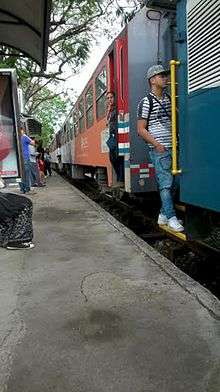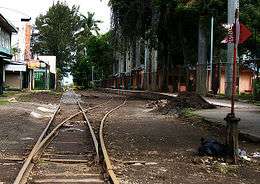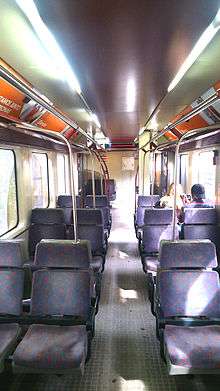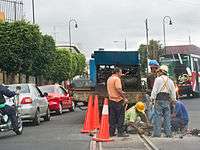Rail transport in Costa Rica



Rail transport in Costa Rica is primarily under the stewardship of Incofer (Instituto Costarricense de Ferrocarriles), an autonomous institution of the state. Incofer owns the national railway infrastructure and operates virtually all freight and passenger services, which consist primarily of commuter trains through the highly populated Central Valley. The whole Incofer network is 1,067 mm (3 ft 6 in) narrow gauge, although there are several small tourist railways of other gauges.
History
In 1871, construction was started on a railroad from Alajuela to Puerto Limón, via San José, on the Caribbean coast; the project was initiated by the government of General Tomás Guardia Gutiérrez and was surveyed in 1868 by the British civil engineer Edmund Wragge. The railroad from Alajuela to San José was completed by the beginning of 1873 and later continued until Cartago. Materials and equipment were brought into Alajuela from Puntarenas by oxen-powered carts. Due to a shortage of finances and natural obstacles (especially around Río Sucio), the construction of the remaining sections was delayed, and the entire line did not become operational until December 7, 1890.
A contract for the building of the Pacific Railroad was signed in 1897, but again, the enterprise faced natural, financial and political difficulties. The Pacific Railroad was officially launched on July 23, 1910, when the first engine, Maria Cecilia, departed from Puntarenas to San José with passengers and cargo.
The transcontinental railway from Limon to Puntarenas became operational in 1910 and was central for the connection of the various fertile regions of the country, as well as linking Nicaraguan and Panamanian railways.[1] The route followed the Atlantic coast until the small port of Matina, before it passed inland to Reventazón River. From there, it bifurcated to cross the northern mountains, with one branch going north of Irazú and the other traversing the Ochomogo Pass. At San José, these lines reunited and the railway continued onto Alajuela, the small Pacific port of Tivives and Puntarenas. The railroad was jointly owned by the state and the Costa Rica railway company, with the latter behind the 1904 arrangement to build several branch lines through the banana districts of the Atlantic littoral.
In 1926, a decision was made to electrify the lines, and the first electric train ran from San José to Puntarenas on April 8, 1930.
The Costa Rican railroad network was damaged during an earthquake in 1991[2] and its operation was suspended in 1995. Since 2000, Incofer has been working to recommence and popularize rail transport again.
Jamaican Railroad Workers
Henry Meiggs Keith, an American hired by the Costa Rican government, was in charge of railroad construction to the Atlantic Ocean. Keith insisted on utilizing "black" (later known as Afro-American) workers for clearing the forest and building the railroad tracks, and in 1872 the first group of Jamaicans entered the country. These Jamaicans and their descendants would become the main inhabitants of the region, thereby establishing a culture that was unique within Costa Rica. Two large Jamaican migrations occurred; firstly, during the railroad construction era, and then in the next century, for the banana plantations owned by the United Standard Fruit Company.
Current status
Although it once connected the Caribbean ports of Limon and Moin with the Pacific port of Caldera, traversing the Central Valley area and Costa Rica's largest cities along the route, the system fell into disrepair towards the end of the 20th century following a financial crisis that saw the President of Costa Rica, José María Figueres, order the cessation of Incofer's commercial activity, resulting in the redundancies of most of its workforce except for a select few who were charged with preserving railway assets.[3]
However, operations were never fully suspended, and there was always at least the occasional freight and maintenance traffic along certain parts of the network. Some other parts, on the other hand, were essentially abandoned until 2005 when urban passenger services were reintroduced along a corridor between the suburbs of Pavas, to the west of San José, and San Pedro, to the east. Since then, services have been greatly increased following investment in second-hand DMUs imported from Spain and the rehabilitation of dozens of kilometres of previously inoperative track. As of May 2014, the bulk of railway operations occur in the Central Valley area and consist of passenger services between the San José suburbs of Pavas, Curridabat and Belen, and between San José and the cities of Heredia and Cartago. Work is now under way to rehabilitate further sections beyond these main termini, such as between Heredia and Alajuela, and from Cartago to Paraiso, in order to extend the existing services.[4]
Trains (particularly freight trains, as well as a privately operated tour train) ran between San José and the port of Caldera until 2011, when a short section of the line was compromised following the construction of National Route 27. This prompted a dispute between Incofer and the highway developer, Autopistas del Sol. This dispute has not yet been resolved and Incofer officials have been quoted as saying that while they are technically able to run trains over the damaged section, it is dangerous to do so. Unfortunately, the resulting lack of regular traffic on this line has facilitated the theft of rails.[5]
Visitors to Costa Rica may perceive the railway as being somewhat limited compared to other forms of transport, due to the current lack of anything except a basic commuter service.[6]
Suburban rail
As of 2013, Incofer operates suburban commuter trains from San José to Curridabat, running via San Pedro (4 km East) and reaching Belen (12 km West). There are also trains to Heredia and Cartago. Freight trains run near the port of Caldera in Puntarenas, as well as within the Limon Province.
Currently the service operates from two main terminals which are the old Atlantic and Pacific stations located in San José Downtown, around 3 kilometers from each other. Incofer has bought many Apolo 2400 series railcars from the former narrow gauge operator in Spain, FEVE. Those cars are used in the commuter train service with complementary operations of so-called "conventional trains" (old General Electric diesel locomotives pulling old passenger cars built in Costa Rica).
FERISTSA
The proposed FERISTSA Railway would connect Mexico with Panama, passing through Costa Rica.[7]
There are no connections to Panama or Nicaragua.
Freight transport
- Freight trains San José - Caldera (Incofer)
- Freight trains from Puerto Limón to Fortuna and towards Guápiles, mainly for Banana transportation, as from 2007 on steel and construction materials have been added to the freight transported
Passenger transport overview
.jpg)
In 2006, the following trains ran in Costa Rica:
- Tico Train Tour San José - Caldera (91 km), weekend tourist trains, privately managed using infrastructure of Incofer
- Commuter trains San José - San Pedro, Universidad Latina (4 km, Incofer)
- Commuter trains San José - Pavas (6 km along the same line as Tico Train Tour, Incofer)
As of August 2008:
- The commuter trains are no longer running.
- The Tico Train Tour is not running to Caldera due to track issues but plans to be operational in November.
- The Tico Train Tour runs an abridged trip to Atenas on irregular weekends.
As of October, 2008:
- A commuter train is going to operate from Heredia to San José, and the rail line is being cleaned and prepared. It was a trial run and it derailed during a trip with government officials. The locomotives have been slowly approaching Heredia center city in the last weeks of the month.
- It is expected that this service will start its operation in December.
As of December 2008
- Apolo 2400 Diesel Multiple Units introduced.
As of March 2009
- Commuter trains Pavas - San José - San Pedro Universidad Latina have been running during morning and evening peak hours, some services are operating with a long train of locomotive and coaches, others are operating with an Apolo railcar, refurbished by Incofer.
- The Tico Train Tour is running every Saturday and Sunday as usually, transporting more than 350 people per trip
As of August 2009:
- The commuter train between Heredia and San José is now operating at peak hours in both the morning and night shifts, many accidents and non related public protests have made it difficult for a fluid service.
- Both the Spanish railcars and the other locomotives are used in the Heredia - San José service.
- Commuter trains Pavas - San José - San Pedro Universidad Latina have been running during morning and evening peak hours, some services are operating with a long train of locomotive and coaches, others are operating with an Apolo railcar
- Many other communities have expressed interest in enabling the train passenger service, like Cartago, Ciruelas and Alajuela.
- The Tico Train Tour is running every Saturday and Sunday as usually, transporting more than 350 people per trip
- There are plans to run a suburban service between Puerto Limón and Moin on the Atlantic coast
As of April 2011:
- The commuter train is running every 30 minutes between Heredia and San José (Estación del Atlántico) at peak hours in the morning (6am to 9am) and evening (3:30pm-8pm). Journey time: 30 minutes, Price: 380 colones.
- Commuter trains Pavas - San José - San Pedro, was extended to reach Curridabat. Services are hourly in the morning and evening. Price: 200 colones.
- The train between San José (Estación del Pacífico) and Belen was officially inaugurated on 1 April. The journey takes half an hour
- Special Services to National Stadium: Due to the opening of the national stadium, special services have been operating at weekends between Curridabat, Heredia and the National Stadium in La Sabana.
As of May 2013:
- The commuter train is running about every 30 minutes between Cartago and San José (Estación del Atlántico) at peak hours in the morning (5am to 8:40am) and evening (3:30pm–7:30pm) from Monday to Friday. Journey time: 43 minutes to one hour, Price: 550 colones.
- New stations were built in Curridabat, Tres Rios and the Cartago station was reopened with two platforms.
- Tourist trips (Cartago-San José-Cartago) take place on Saturdays and Sundays.
Heredia - San José
| Heredia - San José Railway | |||||||||||||||||||||||||||||||||||||||||||||||||||||||||||||||||||||||||||||||||||||||||||||||||||||||||||||||||||||||||||||||||||||||||||||
|---|---|---|---|---|---|---|---|---|---|---|---|---|---|---|---|---|---|---|---|---|---|---|---|---|---|---|---|---|---|---|---|---|---|---|---|---|---|---|---|---|---|---|---|---|---|---|---|---|---|---|---|---|---|---|---|---|---|---|---|---|---|---|---|---|---|---|---|---|---|---|---|---|---|---|---|---|---|---|---|---|---|---|---|---|---|---|---|---|---|---|---|---|---|---|---|---|---|---|---|---|---|---|---|---|---|---|---|---|---|---|---|---|---|---|---|---|---|---|---|---|---|---|---|---|---|---|---|---|---|---|---|---|---|---|---|---|---|---|---|---|---|
Legend
| |||||||||||||||||||||||||||||||||||||||||||||||||||||||||||||||||||||||||||||||||||||||||||||||||||||||||||||||||||||||||||||||||||||||||||||
The Heredia, Costa Rica to San José, Costa Rica service runs only on weekdays in the morning (06:30-08:30) and in the evening (15:30-20:00) with trains leaving every half hour.
This service is operated at street level, which makes it difficult to achieve an optimum speed due to frequent encounters with busy streets, at average the speed is at about 20 kilometers per hour. The service has three stops at stations without staff, in Miraflores (Heredia), Santa Rosa (Santo Domingo) and Colima (Tibás). Still, it's a lot faster than the bus which can take more than an hour at these times.
Pavas - Curridabat
This line runs from Pavas (a slum to the west of San José) through the south of the city to Estación Pacífico and then on to Estación Atlántico and from there east to the UCR, U Latina and Curridabat. Service is hourly in the early morning and evening (weekdays only).
San José - Belen
Trains leave from Estación del Pacífico and take 30 minutes to reach Belen (which is a little city just south of San José international airport).
San José - Cartago
This new route opened in May 2013, the journey time is expected to be 43 minutes between San José (Estación Atlántico) and Cartago with 5 stops (UCR in San Pedro, Universidad Latina, Curridabat, UACA in Cipreces and Tres Rios). Price will be 550 colones.
Noise and accidents
A critical issue is that there are no barriers or lights at level crossings, only a warning sign at every one of the many grade crossings. Train airhorns are used to warn pedestrians and cars at every grade crossing of an incoming train. This is in order to prevent accidents, which have been registered, but due to the train's low speeds, they result in non-fatal accidents. There have been, as well, registered complaints about the train's loud horns (same air horns used in freight trains in other countries), but they have been overruled due to the necessity to warn traffic and pedestrians. Also many Costa Ricans feel identified with the train horns since they have been used ever since the railroad started operations.
It is also noted, that the train horn is a necessity. Recent studies show, that when the train horn is not in operation, accidents tend to double, even at railroad crossings with proper drop needles, lights and warning signs.[8]

Other problems include single-track running, out-of-shape sleepers, joints with gaps, lack of flange oilers in tight turns, track bed out of shape, sunken in several places, bent rail tracks, and worn rail track heads. Also, there is a lack of information at stations about timetables and prices.
| Pavas - Curridabat Railway Service | ||||||||||||||||||||||||||||||||||||||||||||||||||||||||||||||||||||||||||||||||||||||||||||||||||||||||||||||||||||||||||||||||||||||||
|---|---|---|---|---|---|---|---|---|---|---|---|---|---|---|---|---|---|---|---|---|---|---|---|---|---|---|---|---|---|---|---|---|---|---|---|---|---|---|---|---|---|---|---|---|---|---|---|---|---|---|---|---|---|---|---|---|---|---|---|---|---|---|---|---|---|---|---|---|---|---|---|---|---|---|---|---|---|---|---|---|---|---|---|---|---|---|---|---|---|---|---|---|---|---|---|---|---|---|---|---|---|---|---|---|---|---|---|---|---|---|---|---|---|---|---|---|---|---|---|---|---|---|---|---|---|---|---|---|---|---|---|---|---|---|---|---|
Legend
| ||||||||||||||||||||||||||||||||||||||||||||||||||||||||||||||||||||||||||||||||||||||||||||||||||||||||||||||||||||||||||||||||||||||||
Swiss railroad
At the Hotel Los Héroes in Nuevo Arenal, Tilarán Canton (Guanacaste Province), a Swiss hotelier has built a mountain railway for the guests of his panorama restaurant, Pequeña Helvecia (little Switzerland). The rolling stock had been originally used by a Swiss farmer from Chéseaux, who built a 600 mm (1 ft 11 5⁄8 in) field railroad but never got a permission to run it. The hotellier bought it in 1999 and put in operation in 2000 as a tourist attraction under the name "Tren Turistico Arenal". In 2004, it was 3.5 km long, with an elevation of 200 m and two tunnels.[9]
See also
- Costa Rica
- FERISTSA
- Transportation in Costa Rica
- Rail transport in Central America
- Rail transport by country
- Afro Costa Rican
References
- ↑ The 1911 Classic Encyclopedia (27 October 2006). "Costa Rica". The 1911 Classic Encyclopedia. The 1911 Classic Encyclopedia. Retrieved 7 May 2012.
- ↑ Dr. T. Leslie Youd (1993). "LIQUEFACTION, GROUND FAILURE AND CONSEQUENT DAMAGE DURING THE 22 APRIL 1991 COSTA RICA EARTHQUAKE". LIQUEFACTION, GROUND FAILURE AND CONSEQUENT DAMAGE DURING THE 22 APRIL 1991 COSTA RICA EARTHQUAKE. EERC Library. Retrieved 7 May 2012.
- ↑ "INCOFER: Historia de la institución" [INCOFER: History of the institution] (PDF) (in Spanish). Instituto Costarricense de Ferrocarriles. Retrieved 12 May 2014.
- ↑ "Jerarca de Incofer afirma que uso del tren para transporte de carga y llegada a Paraíso y Alajuela son tareas pendientes" [Chief of Incofer confirms operation of freight train and reaching Paraíso y Alajuela remain unfinished jobs]. La Nacion (in Spanish). Grupo La Nacion. 22 April 2014. Retrieved 12 May 2014.
- ↑ "INCOFER incumplió con restauración del tren San José-Caldera" [INCOFER did not fulfill promise to restore San José-Caldera train]. Semanario Universidad (in Spanish). Universidad de Costa Rica. 8 June 2011. Retrieved 12 May 2014.
- ↑ "Costa Rica Transportation". Destination360. Destination360. 2012. Retrieved 7 May 2012.
- ↑ "Shaw Group in talks with US railroad cos for Feristsa project, Central America, Infrastructure, news". Retrieved 2010-10-16.
- ↑ Office of Safety (April 1995). "NATIONWIDE STUDY OF TRAIN WHISTLE BANS". U.S. Department of Transportation Federal Railroad Administration. Noise Pollution Clearinghouse. Retrieved 7 May 2012.
- ↑ Info at Ferrolatino.ch
External links
| Wikimedia Commons has media related to Rail transport in Costa Rica. |
- AmericaTravel, operator of Tico Train Tour (history, stations, pictures)
- Incofer (basic info, contact)
- Unofficial timetables of Central American railroads
- Chronology of the Railroad in Costa Rica (history, pictures)
- The Tramways of Costa Rica
- Unofficial site with time table, history and more
- Banana-Expres animadoc about interactions between the railroad construction and Costa Rica's development